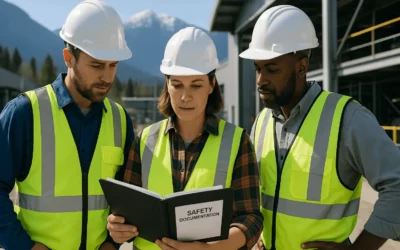Manage employee health and workplace safety
One of the most important steps you can take to ensure workplace safety is to manage employee health and well-being. This includes ensuring that employees are properly trained in how to use and maintain equipment and making sure they’re informed of potential hazards and safe working practices. Ensure proper training and instruction for employees Make sure your staff receives regular training on safe work practices. This should include information on hazardous materials, first aid procedures, and other safety guidelines. If there are any changes to the workplace or new hazards that need to be addressed, make sure your employees are up-to-date on the changes. Keep track of injuries and accidents In order to manage and prevent injuries, it’s important to keep track of how often they happen. This can be done through accident reports or via other means such as surveillance footage. If an injury occurs, collect information about what happened (i.e., who was present when the incident occurred), and how it happened.
Employers
You’re also responsible for ensuring that your workplace is safe. This includes taking all necessary precautions to prevent accidents and injuries and providing adequate safety equipment and training for your employees. If you or someone you know has been injured in a work-related accident, please seek legal advice. Calibre Business Solutions Inc can provide guidance on filing a workers’ compensation claim and other possible legal remedies.
Employer responsibilities
There are a number of things you can do to help ensure workplace safety and health. These include: – Ensuring that your employees are properly trained in how to use and maintain equipment. – Make sure they’re aware of potential hazards and safe working practices. – Keeping track of injuries and accidents so that you can identify and address any problems promptly.
Rights of employees
Employees have a number of rights when it comes to safety and health at work. These include: – The right to be free from workplace hazards and injuries. – The right to safe and healthy working conditions. – The right to receive information about workplace health and safety hazards.
Duties of employees
Employees have a number of duties when it comes to workplace safety and health. These include: – Reporting any accidents or injuries they experience. – Ensuring that equipment is used safely and correctly. – Taking steps to prevent accidents from happening in the first place. – Reporting any safety and health hazards they notice.
Accident investigations and reporting
If an accident occurs, it’s important to gather as much information as possible. This includes: – Recording the date, time, and place of the accident. – Describing what happened and who was involved. – Take photographs or video of the scene if possible. – Collecting any evidence that may be useful in investigating the cause of the injury or accident. – Reporting the accident to your employer and any relevant authorities.
Occupational Health and Safety Compliance standards
Health and Safety set out the standards of health and safety that employers must follow. These include: – The safe use of workplace equipment and materials. – The prevention of accidents. – The protection of employees from harmful conditions in the workplace.
Completion of Occupational Health & Safety Assignments
In order to maintain compliance with health and safety requirements, employers may require employees to complete occupational health and safety assignments. These can include: – Conducting workplace inspections. – Reviewing and improving workplace Safety Procedures. – Making suggestions for reducing the risk of accidents or injuries in the workplace.
Refusal to Work (RTW)
If an employee feels that they have been forced to work in a hazardous or unsafe environment, they may file a refusal to work (RTW) complaint. This can include: – Facing unsafe and unhealthy working conditions. – Not being given the appropriate safety equipment or training required for their job. – Being subjected to verbal abuse or harassment from co-workers.
Investigation of fatality or serious disabling injury
If an employee is killed or seriously disabled as a result of an accident at work, the employer may be required to launch an investigation. Notifying WorkSafe of the Injury within 24 hours of it happening This can include: – Collecting evidence and interviewing witnesses. – Reviewing workplace safety procedures and equipment. – Assessing the health and safety of employees in similar roles to those of the victim. – Making any necessary changes to the workplace.
08 Steps to a Safe and Healthy Workplace
In order to create and maintain a safe and healthy workplace, employers should follow these ten steps: – Review and update Safety Procedures regularly. – Train employees on how to safely do their jobs. – Invest in safety equipment and materials that are appropriate for the job. – Conduct regular workplace health and safety inspections. – Work with unions if they exist to negotiate Health & Safety policies that are acceptable to both parties. – Deal with any problems quickly and appropriately, using effective communication strategies when necessary. – Maintain records of Safety and Health incidents and injuries. – Work with co-workers and management to create a healthy and safe workplace culture.
The Importance of Keeping Your Workplace Safe
The health and safety of employees are of paramount importance to any business. Following the guidelines in this article can help to make your workplace as safe as possible.
Workplace Safety Defined
Workplace safety refers to the health and safety of employees in the workplace. It encompasses everything from ensuring that procedures and equipment are safe to using effective communication and problem-solving techniques when things go wrong. Work Safety Statistics in Canada According to WorkSafeBC, there were over 5,000 reported workplace accidents in 2017 alone. Of these, injuries resulted in 2,593 cases of temporary or long-term disability and 40 fatalities. The majority of incidents (2,379) involved workers being injured while performing their duties at work.
Identify all the workplace safety hazards
Before you can begin to make any changes to your workplace safety procedures, you first have to identify all of the potential hazards. This includes things like dangerous equipment and materials, faulty or insufficiently maintained machinery, and unsafe working conditions.
- Update Safety Procedures regularly
Make sure that the Safety Procedures for your business are up-to-date and reflect the current hazard risks. This will help ensure that everyone in your workplace is aware of what’s required in order to stay safe.
- Train employees on how to safely do their jobs
Ensure that every employee knows exactly how to do their job and how to safely handle the equipment and materials they’re used to working with. This will help reduce the number of injuries and accidents that can occur.
- Use safe Workplace Practices
Follow all of the safe work practices that are in place, including wearing appropriate safety gear, using caution when moving or handling heavy objects, and following established procedures for emergency situations.
- Address any Safety Concerns Immediately
If you ever notice an unsafe situation or see someone being abusive towards another employee, take steps immediately to address it. Doing so may prevent a more serious accident from occurring.
Keep employees aligned to foster a culture of safety
Ultimately, the best way to keep employees safe and compliant with workplace safety procedures is to ensure that they’re aligned with company values and goals. This will help them understand and embrace the importance of safety in their work, and discourage them from taking unnecessary risks.
Define safety policies and remind employees to follow them
It’s important to have clear and concise safety policies in place and make sure that employees are always reminded of them. This will help ensure that everyone knows what is required of them when it comes to workplace safety. Ensure safe working conditions by properly maintaining machinery and gear In order for workers to be safe on the job, equipment and machinery must be properly maintained. If something is not up to par, it can lead to dangerous situations or injuries for employees.
Enable easy access to important documents and information
It’s important to have easy access to documents and information that relate to workplace safety. This way, employees can quickly and easily find the information they need in order to stay safe and compliant. Provide adequate training and supervision In order for employees to be safe and compliant on the job, they need adequate training and supervision. This means that managers must make sure that employees are getting the education and instruction they need in order to stay safe.
Recognize those who follow the rules and regulations
Those who follow safety policies and regulations and take necessary precautions to avoid injury or harm will be recognized and rewarded. This can help create a culture of safety in the workplace, and encourage others to do the same.
Ways to Create a Safe Working Environment
There are a number of ways that you can create a safe and healthy working environment for your employees.
- institute clear and concise safety policies and remind employees of them regularly
- ensure equipment and machinery are properly maintained
- provide adequate training and supervision to employees
- promote a safe and healthy work environment
Being Aware and Identifying Workplace Hazards
It’s important for employees to be aware of and identify workplace hazards. This way, they can take necessary precautions and avoid dangerous situations or injuries. When Workplace Hazards are Present If you notice any of the following at work, it’s important to take action: -Immediately stop what you’re doing and assess the situation – If there are any potential safety concerns, act quickly to address them. -Report the hazard – If you observe a hazardous condition that is causing injury or harm to your employees, report it immediately. You could be liable if not reported correctly.
Implementing Workplace Safety Programs
workplace safety programs can help to prevent injuries and make your workplace safer. Programs can include: – hazard identification and risk assessment – safe working practices and procedures – first aid and health and safety training – management and coordination – emergency response plans Promoting a Safe and Healthful Workplace Culture Safe and healthful workplace culture can help to create a safe and healthy working environment for employees. Programs that promote safety and wellness in the workplace include: – creating clear safety policies and procedures – providing adequate training and supervision – promoting healthy workplace habits and practices
Providing Proper Safety Training to Employees
Employees need adequate safety training to protect themselves and avoid workplace injuries. Programs that provide safety training include: – Safety and Health Training Certificate Program (SHTCP) – OSHA 30-Hour Safety and Health Training Course – Workplace First Aid/CPR/AED Certification Programs In order to prevent injuries and ensure a safe workplace, it’s important to have an effective safety and health program in place. Programs that can help include hazard identification and risk assessment, safe working practices and procedures, first aid and health and safety training, management and coordination of the program as well as emergency response plans.
Reporting Unsafe Working Conditions
If you notice any unsafe or hazardous working conditions, you must report them to your supervisor. You can also report unsafe and hazardous working conditions using the OSHA 30-Hour Safety and Health Training Course In order to make sure that workplace health and safety programs are effective, it is important for employees to know their rights and how to file a complaint if they believe that their rights have been violated. Programs that teach employees about their rights include: – Right To Know Program – Whistleblower Protection Programs
Promoting Regular Breaks
It’s important for employees to take regular breaks to rest and recover from their work. Programs that promote breaks include: – Safety and Health Training Certificate Program (SHTCP) – Worker Adjustment and Retraining Notification Act (WARN) Programs Breaks are an essential part of a safe workplace, and it’s important that employees are given the opportunity to take them.
Using Mechanical Aids
Where possible, mechanical aids should be used in an effort to reduce the risk of injuries. Programs that promote the use of mechanical aids include: – Safety and Health Training Certificate Program (SHTCP) – Workplace First Aid/CPR/AED Certification Programs – Safety and Health Standards of the Canadian standard Z99.1 When using mechanical aids, it’s important to follow safe working practices and procedures, including: – checking the equipment for proper operation before use – following safety guidelines when handling or operating the equipment.
Ensure a safe work environment: Return-to-Work
If an employee is unable to return to work due to a health condition, the employer must take all reasonable steps to ensure that the employee’s safety and welfare are protected. Programs that promote safe return-to-work include: -Modified work programs – Safety and Health Training Certificate Program (SHTCP) – Workplace First Aid/CPR/AED Certification Programs – Safety and Health Standards of the Canadian standard Z99.1



